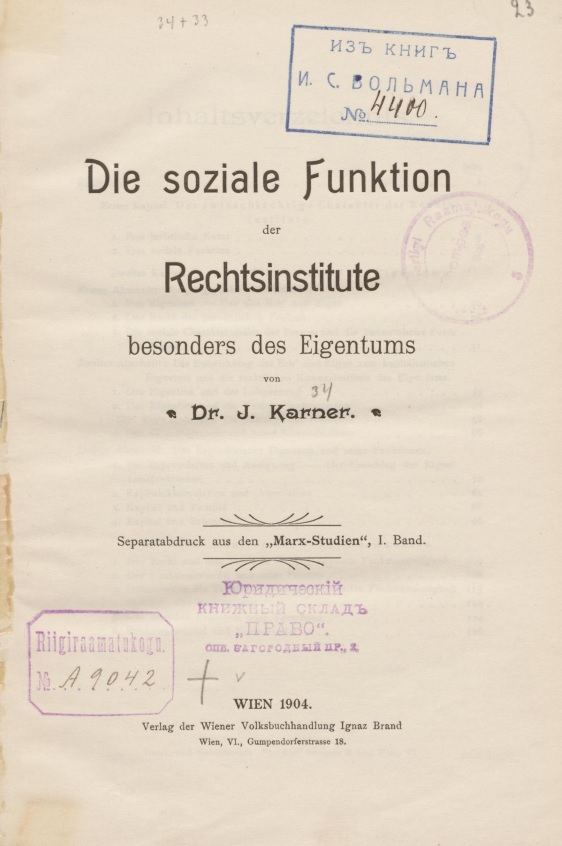Biblioteca / 1940-1949
Karl Renner. The Institutions of Private Law and Their Social Functions.
Londres: Routledge & K. Paul, 1949. 307 páginas.
Edición original, J. Karner [Karl Renner]. Die soziale Funktion der Rechtsinstitute, besonders des Eigentums. Viena: Wiener Volksbuchhandlung Brand, 1904.
Karl Renner (1870-1950)
CONTENTS
Introduction / O. Kahn-Freund
I – LEGAL INSTITUTIONS AND ECONOMIC STRUCTURE
Section I. The Problem
1 – Norms
2 – Legal Institutions and their Component Norms
3 – The Economic and Social Functions of the Legal Institutions
Section II. The Organisation; and the Correlation of the Functions
1 – The Organising Functions
2 – The Economic Function in Particular
3 – The Concept of the Social Function
II – THE FUNCTIONAL TRANSFORMATION OF PROPERTY
Section I. Principles and Methods of Analysis
1 – Patrimonial Property
2 – Transformations in the Substratum of Property
3 – The Right of Personal Freedom
4 – The Social Character Mask of the Persona and the Economic Form of the Res
Section II. The Development of Capitalist Property and the Legal Institutions Complementary to the Property Norm
1 – Property and the Contract of Employment
2 – The Most Recent Development of Property and Labour
3 – Property and the Contracts of Alienation
4 – Property and the Contracts of Restitution
5 – Landed Property and its Complementary Institutions
Section III. Capitalist Property and its Functions
1 – The Function of Appropriation
2 – The Function of Accumulation
3 – Expropriation as a Function of Capitalist Property
4 – Mutual Displacement of Surplus Value and Wages Revenue
Section IV. Capitalist Property and the Law Relating to Associations
1 – Accumulation and Association
2 – Association and Ownership
3 – Association and Credit
Section V. Property and the Law of Family Relationships
1 – Family and Income
2 – The Capitalist’s Household
3 – The Worker’s Household. Social Insurance
4 – Additional Contributions to the Wages Fund
5 – The Family of the Worker
Section VI. Ownership and the Law of Succession
III – SOCIOLOGICAL ANALYSIS OF FUNCTIONAL CHANGE
Section I. Norm and Substratum
1 – Change of the Substratum. Economic Evolution
2 – External Limits ofthe Efficacy of the Norm
3 – The Change of Functions and the Absolute Lack of Functions
4 – Ineffective Functioning. “Idolatry of the Decree”
Section II. The Change of Function and Its Various Forms
1 – Purely Quantitative Changes
2 – Social Interconnections
3 – The Divorce of Technical from Legal Use
4 – Dissociations into Partial Functions
5 – The Function as a Whole
Section III. The Function Becomes Divorced from the Legal Institution
1 – Property Becomes Divorced from the Owner
2 – The Capital Function is now Detached from the Res
3 – The Object Acquires Many Functions. The Subject is Deprived of All Functions
Section IV. The Unit of Business and the Unit of Property Cease to Coincide
1 – The Size of the Working Concern as Technical Optimum
2 – The Size of the Concern as a Fortuitous Incident of the Law
3 – Property as an Impediment to Concentration and Nationalisation
Section V. Modern Possessions. The Aggregate of Assets and Liabilities
Section VI. The Development of the Law
1 – Change of Functions and Change of Norms
2 – Complementary Institutions Displace the Principal Institution
3 – Complementary Institutions of Public Law Force the Private Law Institutions into the Background
4 – Legal Doctrine and the Tasks of Society

